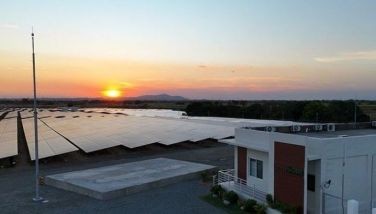Tariff wars worsen

China gets the message: Donald J. Trump’s terrifying tariffs are mainly directed at Beijing.
United States tariff on China exports will rise to 104 percent, from the 34 percent announced by Trump on April 2, 2025. Tariffs on 165 countries will rise to a minimum of 10 percent (Singapore) and a maximum of 104 percent (China), by midnight April 9, Wednesday (Thursday noon in Manila).
Trump has always been wary of China’s growing economic – and military – power. In his view, China is the enemy, not Russia. In May 2024, in Beijing, Xi Jinping and Vladimir Putin pledged a “new era” of partnership against the US which they fret is an aggressive Cold War hegemon sowing global chaos. Previously, in 2022, Xi and Putin declared “no limits” to their friendship.
In response, using his own version of “divide and rule,” Trump has befriended Putin and allowed him to keep the 20 percent of Ukraine’s territory that Russia’s three-year invasion has captured, for which China has given Russia material and diplomatic support.
In 2017, Trump I launched a Section 301 investigation into China’s innovation and intellectual property policies deemed harmful to US economic interests and raised tariffs by 25 percent on $250 billion worth of imports from China. In retaliation, China increased tariffs (ranging from five to 25 percent) on $110 billion worth of imports from the United States. In January 2018, Trump imposed 30-50 percent tariffs on Chinese solar panels and washing machines.
Ironically, it was the US which encouraged China to join the World Trade Organization, in 2001. The idea was that a more outward looking or “civilized” China would be better for the prosperity and peace of the world. China went on to become an economic powerhouse and the world’s manufacturing center. The joke became: “China makes everything; the rest is made by God.”
In 2024, China had total foreign trade of $3.577 trillion, 7x the $509 billion in 2001. US-China trade in 2024 was $584.2 billion, 5x 2001’s $120 billion.
China used its trade surpluses to rescue 800 million Chinese from poverty, the greatest social mobilization in world history, and build up its military. Today, China has a bigger army, 3.17 million, than the US, 2.12 million. The Chinese navy is bigger than the US navy, 730 vessels vs. 472; 380,000 personnel vs.13,500. In soft power, China has influence on a greater number of the world’s population.
With the latest 104 percent tariff, the price of nearly everything China ships to the US doubles, especially at retail. The $1,000 iPhone will now retail for at least $2,000. About 90 percent of iPhones Apple sells to the world come from China, whose US tariff has risen from 20 percent under Trump I, to 34 percent on April 2, 2025 and finally to 104 percent on April 9.
China vows to fight back and “fight till the end.” It slapped a 34 percent duty on imports from the US. Angered, Trump retaliated with an additional 50 percent tariff to bring total tariff on China goods up to 104 percent. “It was a mistake for China to retaliate,” White House press secretary Karoline Leavitt protested on April 8.
Apple iPhones aside, the biggest impact on consumers of high tariffs is on their food. In 2024, soybeans were the biggest US export to China, primarily to feed China’s estimated 440 million pigs, followed by pharmaceuticals and petroleum. Main China exports to the US include electronics, computers and toys. It becomes a question of which is more important: food or computers and gadgets?
At the White House on Monday (April 7) afternoon, Trump said: “We’re going to get fair deals and good deals with every country, and if we don’t, then we’re going to have nothing to do with them.”
Before yesterday, Apple was moving its production of iPads and AirPods from China to Vietnam, and of iPhones to India. But Vietnam has been hit by a 46 percent tariff, and India 26 percent. So iPads and AirPods will probably cost 50 percent more when sold in the US, and some India-made iPhones by at least 26 percent.
World leaders whose countries are badly hit by high tariffs are making a beeline to Trump and to Washington DC to cut deals. Tuesday, Trump said “sometimes you have to mix it up a little bit.” He claimed the tariffs are already bringing in $2 billion a day. He will entertain lobbying world leaders. His focus in the days and weeks ahead is on making “tailored deals with various countries.” The White House said more than 70 countries are lobbying for their respective tariff deals.
“Don’t retaliate and don’t escalate” is the advice of Trump officials to world leaders hurt by the tariffs.
Meanwhile, our officials have been scored by critics for their seemingly lackadaisical reaction to Trump’s tariffs. The Philippines is hit with 17 percent, the second lowest in ASEAN after Singapore’s 10 percent.
The influential Management Association of the Philippines, which counts 1,000 CEOs for its members, has called for the formation of an Economic Security Council composed of experts from government and the private sector to do modeling analysis of the tariff wars.
The Philippine Chamber of Commerce and Industry, the country’s largest business group, urges swift, strategic action to help contain the potential economic fallout from the 17 percent tariff on Philippine goods, adding the uncertainty over which specific export products will be affected leaves local industries vulnerable to potential disruptions. “The US has yet to announce the exact coverage, but we remain vigilant as such tariffs typically target specific categories of goods such as food and agri products and electronics, which are our major exports,” the PCCI said in a statement.
* * *
Email: biznewsasia@gmail.com
- Latest
- Trending























